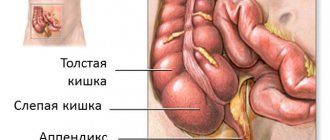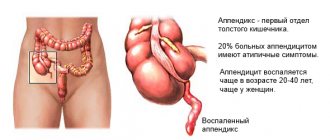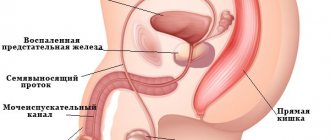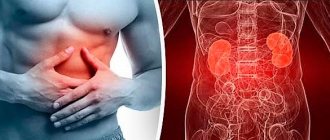Acute appendicitis is one of the most common surgical diseases in children and adolescents. About 75% of all emergency operations in children are performed for inflammation of the appendix, and the vast majority of patients are schoolchildren over 14 years of age.
Due to the prevalence of the disease, it is important for parents to remember: any complaints of abdominal pain are a reason to be attentive to the health of their child. The most characteristic difference in the course of appendicitis in children and adolescents is its rapid development. Processes that develop over several days in adults occur in a child in a matter of hours.
Diagnosing the disease on your own is very difficult; the first signs of appendicitis in a child or teenager may resemble food poisoning, overeating, exacerbation of gastritis, duodenitis or other gastrointestinal diseases. In the absence of timely medical care, it can lead to serious complications, such as intestinal obstruction, and if the inflamed appendix ruptures, general peritonitis, sepsis, and death.
Where does appendicitis hurt?
Accurate knowledge of the nature of pain in appendicitis and its location helps to identify the disease in adolescents and differentiate it from other conditions. When lightly pressing on the abdomen, parents feel a small lump. At this point, the teenager will talk about the acute pain that may disappear when the hand is removed. If the syndrome persists, the child has indeed developed appendicitis.
Abdominal pain in a teenage girl can be a harbinger of menstruation. The syndrome also occurs with inflammation and ovarian cysts or ectopic pregnancy, if a young person is 15–16 years old and is sexually active. To confirm/exclude appendicitis, it is important to find out the date of the last menstruation from the girl and undergo an examination by a gynecologist.
When a child aged 12–13 years complains of periodic abdominal pain, it is necessary to visit a therapist or surgeon and undergo a series of diagnostic measures:
- Palpation and history taking.
- Detailed blood and urine analysis.
- Bacterial culture of stool for infection.
- X-ray and ultrasound of the abdominal organs.
Symptoms
Sometimes the only symptom a child talks about is pain. The stomach hurts, the lower part hurts, the pain is dull, it does not necessarily appear at the location of the appendix. This is a serious complaint that is important to promptly address. There may be no other symptoms if the inflammation is acute.
If there is severe pain in the area of the intestine or in the umbilical area, you should call an ambulance. In addition to pain, vomiting and fever are observed - not always. To make an accurate diagnosis, it is recommended to call a doctor who will take the patient by ambulance to the hospital, where they will perform an ultrasound of the abdominal cavity and take an x-ray. Diagnostic methods will allow you to clarify the specifics of the disease, make a diagnosis in order to take immediate treatment measures.
In girls during adolescence
Manifestations of appendicitis in girls approaching puberty, who have already reached this stage of maturation, are blurred and resemble an inflammatory disease of the genital organs.
The pain radiates to the lower back, and when it enters the purulent stage, it is felt in the pubic area, perineum, reminiscent of gynecological manifestations. Mixed symptoms require examination for appendicitis, including a gynecological examination, which excludes the possibility of developing female diseases due to hypothermia and other reasons.
In teenagers
Symptoms in boys and in most girls in adolescence begin with a throbbing, dull pain in the hypochondrium on the right side. In boys, when palpating the abdomen, the right testicle is pulled up. This is the beginning of a purulent period, which lasts up to 12 hours. The pain radiates to different parts of the body up to the forearm, which makes diagnosing the disease difficult. The pain syndrome is accompanied by dry mouth, thirst, increased temperature and excitability, and increased heart rate. One-time vomiting occurs. Similar symptoms are typical for exacerbation of gastritis, pancreatitis, cholecystitis, and if similar situations have occurred in the past, you should urgently consult a doctor.
Early signs of appendicitis
Inflammation of the cecum in adolescent children manifests itself with the same symptoms as in adults. The very first sign of appendicitis in them is a sharp pain in the abdomen. The syndrome is constantly present and persists when the position of the body changes. Here are other symptoms of appendicitis in teenagers:
- Constipation.
- General weakness.
- Nausea and vomiting.
- Poor appetite.
- Thick white coating on the tongue.
- Increased body temperature (usually 37°C, occasionally rising to 39°C).
Symptoms
Symptoms depend not only on age, but also on the location of the appendix.
Common symptoms of appendicitis in teenagers:
- pain in the right iliac region;
- nausea, vomiting;
- loss of appetite;
- dry mouth, plaque on the tongue;
- increase in body temperature to 37-37.3˚C;
- constipation or diarrhea;
- increased heart rate.
Unlike young children, adolescents vomit once or twice . They are also characterized by the symptom of “toxic scissors”. It is manifested by an increase in heart rate to 100-120 beats per minute against the background of low body temperature.
First signs
The primary and most important symptom is pain . It occurs suddenly, is localized in the navel area, and then moves to the location of the appendix - the lower right part of the abdomen. The pain is constant, does not go away for more than 2-3 hours in a row, increases with bending over and physical activity, coughing, sneezing, and may subside for a short time when lying on your side.
Another early sign is refusal to eat . Sometimes it precedes the onset of pain.
Localization of pain
Depending on the location of the appendix, pain may be felt in the following areas :
- lower right abdomen;
- suprapubic region;
- right hypochondrium;
- left iliac region (very rare);
- small of the back.
Most often, pain is felt in the right iliac region.
For girls
In teenage girls, appendicitis occurs twice as often as in boys . This is due to menstruation, during which blood flow to the pelvic organs increases.
Pain with appendicitis may be perceived by a girl as the onset of menstruation , but other symptoms (nausea, fever and poor appetite) should lead to the idea that the reason is different.
In boys
The symptoms of appendicitis in boys are not much different . Upon examination, it is clear that the right testicle is pulled towards the scrotum. If you press on your stomach, it rises up. When the scrotum is stretched, pain is felt in the right testicle.
Types of appendicitis in adolescents
Surgeons distinguish several types of appendicitis, which occur in adolescents with varying degrees of inflammation.
- Catarrhal acute appendicitis is an early stage of the disease. There is no pain syndrome at all or it is weak.
- Simple appendicitis. This form has the above-mentioned characteristics. Neglecting them leads to complications of the pathology.
- The destructive type causes severe pain and fever.
- The acute phlegmonous form is characterized by increased abdominal pain and hyperthermia. The vermiform appendix fills with pus and ulcerates, easily identified by palpation. The stage is dangerous due to inflammation of the abdominal walls.
- Gangrenous appendicitis is the most severe form, which develops in the absence of medical care. The death of appendix cells leads to a temporary disappearance of pain, but the teenager’s well-being worsens, and infection of the abdominal cavity provokes intoxication of the body.
- Chronic appendicitis. The residual form is a consequence of an acute attack, which resulted in the child’s recovery without surgery. Its specific symptoms are spontaneous aching pain in the right side. During the examination, the teenager is found to have accumulations of fecal stones, delayed emptying of the cecum and unevenness of its lumen.
Pediatrician Komarovsky draws parents' attention to the fact that it takes several hours for a teenager's body to develop serious inflammation. Therefore, at the slightest suspicion of appendicitis, you should not hope for an improvement in your health. You need to call an ambulance.
Forms of inflammation
Appendicitis can be acute or chronic:
- In acute inflammation, the clinical picture is pronounced; within 1-2 days, perforation of the walls of the appendix is likely, followed by purulent inflammation of the peritoneum. Characterized by a rapid increase in pain and tension in the peritoneal muscles. As complications develop, body temperature can rise to 39˚C.
- The chronic form is extremely rare in adolescents. It develops against the background of untreated acute inflammation. We are talking about chronic appendicitis if the child suffered several attacks, which were accompanied by symptoms such as pain in the right lower side, fever and nausea. During the period of remission, dyspeptic manifestations are present in the form of indigestion and constipation. Pain may occur during physical activity.
What to do before the doctor arrives?
How to help a teenager with appendicitis? Until the ambulance arrives, you are only allowed to place a towel soaked in cool water on your stomach. A cold compress will relieve some of the pain. When signs of appendicitis appear, it is strictly forbidden to perform the following activities:
- Give an enema.
- Feed the child (you can give sweetened water).
- Apply warm and hot compresses to the stomach, use heating pads with hot water. Thermal procedures catalyze the inflammatory process.
- Give your teenager painkillers. Medicines relieve the syndrome and blur the clinical picture, which makes diagnosis difficult.
Features of surgical intervention
Conservative treatment of appendicitis in adolescents is prescribed only for appendiceal infiltrate - fusion of the appendix with neighboring organs. But after about a month, the patient still undergoes a planned appendectomy. In other cases, the operation is performed immediately.
Instead of a long incision, the surgeon makes a hole with a diameter of 5 mm and inserts an endoscope. The smart device completely replaces manual intervention, minimizes blood loss and does not affect surrounding tissues. Already 2 hours after the operation, the teenager can walk freely around the ward, and after 2 days he goes home.
- It is important to follow a diet for several weeks after surgery. From the 4th day, the teenager can eat steamed cutlets, liquid porridges, and low-fat soups. Meals are fractional, up to 6 times a day. Drinking regimen – about 2 liters of clean water. You can't drink soda. Products that provoke increased gas formation are excluded from the diet.
- Despite the illness, the child is recommended to lead an active lifestyle. Of course, excessive physical activity is unacceptable, but walking, quiet games or simple housework will not hurt to restore the body.
Remember that a ruptured appendix can cause blood poisoning. Bacteria will fill the circulatory system and affect the functioning of important organs and systems. With timely surgery on a teenager, the prognosis for appendicitis is favorable.
https://youtu.be/kg1mINGa008
Appendicitis is an inflammatory disease of the appendix of the colon, accompanied by pain, characteristic symptoms, and a rapidly deteriorating condition of the patient. An inflamed appendix is a serious risk factor for adults and children, a dangerous disease that requires immediate medical attention in any case. Having discovered the first signs of appendicitis, you should immediately call an ambulance. Any responsible parent should know the symptoms of appendicitis in children.
What complications does appendicitis cause?
Delayed surgical intervention, medical errors and unforeseen situations during surgery lead to various complications. Within 48 hours from the onset of inflammation, the body still controls the situation, and no complications arise. The consequences appear between 3 and 5 days, and they are expressed by the following changes:
- Perforation of the appendix.
- Local peritonitis.
- Thrombophlebitis of the mesentery of the cecum.
- Appendicular infiltration.
From the 6th day the situation worsens. The teenager develops diffuse peritonitis, portal vein thrombophlebitis, liver abscess, and sepsis.
Features of the flow
The disease in adolescents has its own characteristics: there are differences in clinical manifestations and course, and the risk of complications increases.
What is the main danger
Appendicitis in a child appears suddenly and in most cases develops rapidly , within 12 hours. Rarely, symptoms may persist for 5-7 days.
If the disease is not recognized in time, complications are likely that are difficult to eliminate.
If the inflamed appendix is not removed, its walls perforate . The inflammatory process quickly spreads to the peritoneum, resulting in peritonitis. This is the most dangerous consequence; the disease poses a threat to the child’s life.
Note. In adults, complications develop within 2-3 days; in a child, they can occur within 2-3 hours.
Complications
In addition to peritonitis, other, no less dangerous consequences are likely.:
- appendicular infiltrate, abscess;
- intestinal obstruction;
- sepsis.
Catarrhal (uncomplicated) appendicitis can turn into phlegmonous (accompanied by vascular thrombosis) or gangrenous (characterized by tissue necrosis) within 12-24 hours.
Course of the disease
After the first 12 hours without assistance, a phlegmonous stage occurs, characterized by the production of pus. The pain is not wandering, the focus is the lower abdomen, the abdomen is soft. The patient tends to lie on the right side, does not lie on the left, is in the fetal position, pulling his knees to his stomach. The temperature rises to 38 degrees, stool upset occurs.
After a day, the symptoms decrease, but the danger increases - there is a risk of appendix rupture. When ruptured, purulent contents enter the abdominal cavity, creating the risk of peritonitis, sepsis, and death. A decrease in clinical manifestations can be attributed by parents to the improvement of the child’s condition; appendicitis is mistaken for an eating disorder, which creates a danger.
When the appendix fills with pus, the pain gradually decreases, but a strong white coating appears on the tongue, the abdomen swells, and there is no peristalsis. The risks increase; emergency hospitalization is required; if the appendix ruptures, which risks occurring at any moment, the contents spill onto the serosa of the abdominal cavity, which becomes inflamed. Only quick medical help and antibiotics can save lives. Uncomplicated appendicitis carries much less risk than advanced appendicitis.
When the appendix ruptures, the child complains of girdle pain in the abdomen, vomiting begins, which does not stop and intensifies as pus spreads throughout the cavity. The localization of pain is not detected, the abdomen is swollen.
Peritonitis also has stages, including a period of apparent well-being with the disappearance of pain due to failure of nerve endings. The pain goes away, there are almost no complaints, but the pulse remains rapid, tachycardia is present, and sticky sweat appears. Without emergency assistance, after a few hours, deterioration occurs due to severe intoxication, intestinal obstruction, and the risk of death increases.
Localization and nature of pain in the disease
One of the common questions that pediatricians hear is how does appendicitis manifest in a child or teenager?
- A teenager complains of a sharp, severe painful condition in the peritoneum.
- Unpleasant sensations are located in the solar plexus area and surround the navel. The pain may radiate to the back or right side.
- Over time, stomach discomfort and constipation occur.
Location
Pain can manifest itself not only in the usual area, but also in less typical ones. This is due to the fact that appendicitis moves along the abdominal cavity.










